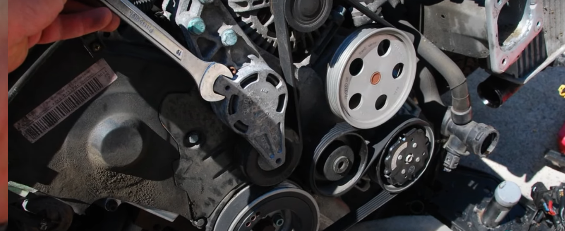Basically, for your battery and electrical system to work perfectly, you need to be aware that the alternator belt is the most important of your car, especially the charging system. The reason is that it’s in charge of the alternator, which produces all the electricity that is needed to run the car’s electrical system with the recharging of the battery.
If the alternator belt slacks, it will cause it to slip on the pulleys and it will decrease its effectiveness and also cause harm to the alternator. So therefore, if the alternator belt is too tight it can cause a premature failure to the excessive wear on the belt with other parts most especially. It is better to know more concerning the symptoms, it will be of assistance on how to fix the alternator belt of your car properly. In other words, identifying the symptoms such as unusual noise, vibrations, and belt slippage very quickly is crucial. Once you notice these symptoms early it will help you not to spend much in terms of fixing your car and also, making sure that your car’s electrical system is operating smoothly is also very important.
In this article, I will be sharing with you the symptoms of an alternator belt and also, how will know when your alternator belt is tight with other tips that I will also share with you as I have made research and provided solutions on them. Join me as you continue to read and you will find this article more enlightening.
Let’s get started.
Tight Alternator Belt Symptoms: How Do I Know If My Alternator Belt Is Tight?
Basically, the essence of the alternator belt is by keeping the engine’s accessories pulleys especially connected when the engine turn downs. The crankshaft pulley rotates the alternator belt which in turn rotates the alternator ac compressor power steering pump but in some other cars the water pump. Normally the expected average life of an alternator belt should be able to last up to a hundred thousand miles. That’s it.
Tight Alternator Belt Symptoms:
1. Squeaking Noise.
In this scenario, there is a squeaking noise and the reason for this is because the belt is stretched out which makes it slip across the pulleys thereby creating a squeaking noise. It simply means there should be a replacement but if you replace the belt and still have that squeaking noise, then it could it be that, it is actually coming from one of the pulleys.
2. Cracking Belt.
This is a definite sign and it should be replaced very quickly, the reason for this could be caused by through normal usage of the engine. And what could accelerate the wear is oil leaks and engine heat with debris.
3. A Torn Belt.
In this situation, the signs of noise cracking can’t be overlooked and it’s because it can eventually start ripping the piece by piece. So, therefore, it simply needs a replacement.
4. Warning Light.
If your belt alternator breaks, it simply means you should look into the battery light, alt-light with the gen light. The reason is that it might be that your charging system is not working properly due to the alternator not turning eventually.
5. Overheating.
When the belt is too tight, it causes excess pressure on the alternator and this might lead to overheating, which can cause danger to the alternator and lead to failure.
So therefore, it is very important to take your vehicle to a skilled mechanic as soon as you notice these symptoms just for them to take a look at the belt tension and then make the necessary adjustments just for the electrical system of your vehicle to be working properly.

How Do I Know If My Alternator Belt Is Tight?
1. Check the tension Belt.
It simply means, take hold of the belt with your finger and then move it from one side to another just to see how far it will deflect in the middle of the run, if you notice it is moving from more than ½ in for about 13 minutes, then it is slack but if there is any less movement then it is too tight.
2. Locate the alternator belt.
The alternator is a black rubber belt, it is usually found wrapped around the alternator pulley, the engine’s crankshaft, and also the crankshaft pulley or other possible pulleys in your car’s engine.
3. Check for proper alignment.
In this scenario, you have to make sure that the belt is correctly aligned with all the pulleys. The reason is that, if the belt is not aligned with the pulleys, then it simply means that, there will be stress on the belt, which can lead to wear and danger to the other parts or components.
4. Take a look at the cracks.
If you notice any of these signs such as cracks, fray, or even glazing then simply take a look at the belt tension. The reason why this sign happens might be that the belt tension needs to be replaced.
In other words, if you are not too sure about the situation of the alternator belt, l will be advised you to take your vehicle to a qualified skilled mechanic to inspect it just to be sure that your belt is at its proper tension also in good condition thereby reducing the damage of your vehicle’s electrical system.
Common Tight Alternator Belt Symptoms?
A conscious vehicle owner will take a look at the alternator belt often just to check for signs of wear, fraying, notches, missing chunks, and also if there is too much slack on the belt or misalignment on the pulleys.
There are also other visual signs too such as cracking, abrasions, rib separation, uneven wear on the ribs or belt, and malfunction or melting.
But the common symptom of the alternator belt is the squeaky noise or worn-out belt, this happens when the automobile is going uphill and running the heater together with the air conditioner all in the same time. It can also take place when the driver is driving over a deep puddle or having an undercarriage car cash. In this scenario, the screeching should be put to stop immediately.
Another common symptom is the broken belt, it can lead to a flapping or flopping sound right under the hood that it is completely broken away, thereby you might hear a tiny frequent tick under the hood as you accelerate but the broken bits of the alternator belt will affect other parts.
What Problem Can Over-Tightening Of Belt Cause?
In this situation, if the belt is over-tightened, it will lead to a burnout that might cause the belt to rotate which includes the alternator power steering pump, A/C compressor, and idler pulleys. In other words, if the belt is over-tightened it can damage any of the pulley bearing that it is connected to.
Can A Tight Belt Cause Alternator Not To Charge?
Of course yes. The belt is very important and so without it, the alternator won’t be able to supply a constant charge to the battery just for the battery to function correctly even while driving your vehicle. So, therefore, the belt has a special role to accomplish. The longer that same alternator belt is on your vehicle, the higher it will be risky to replace it.
Does Alternator Belt Affect Acceleration?
Yes of course. Basically, if the belt tension of your automobile is damaged it will affect the acceleration thereby making it to cause a squeaking noise. Also if it is too tight or loose, it will make cause a slip on the pulleys thereby making the alternator undercharge the battery and also decrease the power for acceleration. But if it is too tight, it can cause an excess disposition on the alternator and also other parts of the engine.
Lastly. If the alternator belt has faded out, it will cause weak or unstable electrical power, which means that it will lead to loss of power or it will affect the acceleration. The reason is that it provides electrical power to the automobile’s system.
How Do You Check Tightness On A Belt?
It’s very simple. All you need to do is by making use of a ruler and then locate the middle point on the belt’s longest stretch, let’s say between the pulleys. Then make use of the ruler to look for the midpoint by using your finger and thumb to move the belt from one side to another, once you are done, take a look at how much it deflects at the middle of the run.
How Tight Should A Belt Feel?
In this scenario, basically, a tension belt should feel tight, but let it not be too tight. There should be a little give especially when pushed or even pulled. But it all depends on your manufacturer’s specifications and also the belt type. So therefore, when taking a look at the tension of your belt, make sure it is around ½ inch to 1 inch or even 10-25 mm.
Conclusion.
In this article, I have proffered a solution on the main focus (Tight Alternator Belt Symptoms: How Do I Know If My Alternator Belt Is Tight?). But I will still be advised that, if you want your vehicle to function properly then, take a look at the belt tension, and look out for the symptoms such as battery not charging, squeaking noise, and warning light. Etc.
Also, a tight belt alternator is very crucial just for the correct function of your car’s electrical system, it will enhance the performance of the engine. But if it is loose or worn it will cause the above symptoms that I mentioned above. So therefore, try making sure to inspect and maintain the alternator belt, it will help to reduce the danger of other components.
